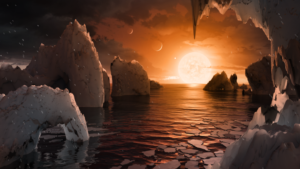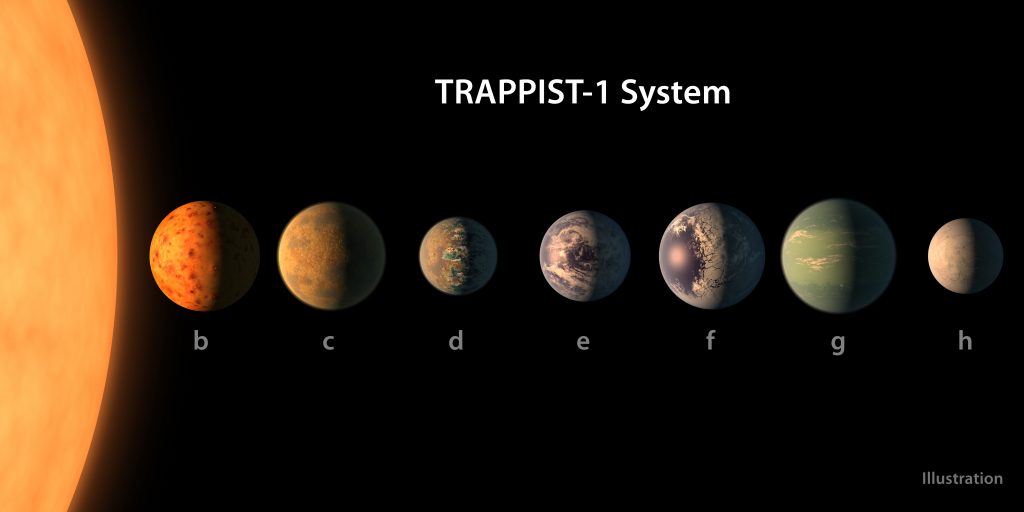Will NASA’s New Discovery Be the Key to Finding Extraterrestrial Life?
 Illustration showing the possible surface of one of the TRAPPIST-1 system planets (image via NASA)
Illustration showing the possible surface of one of the TRAPPIST-1 system planets (image via NASA) This week NASA released news of an astounding discovery—a solar system that may harbor the right conditions for life as we know it. The system is named TRAPPIST-1, not after those monks in Belgium who brew beer, but after the Transiting Planets and Planetesimals Small Telescope used to detect it. TRAPPIST-1 consists of at least seven planets the size of Earth orbiting around one ultra-cool star (which is not my opinion of how neat it is but rather a characterization of effective temperature). This discovery is of particular importance because three of the planets are undoubtedly located in the habitable zone—an area around parent stars where the conditions are right for rocky planets (opposed to gaseous ones) to contain liquid water.
At forty light years away in the constellation Aquarius, it’s difficult for scientists to immediately answer questions regarding the existence of water and life within this solar system. Although TRAPPIST-1 is relatively close to us, due to limitations in technology scientists currently rely on space-based telescopes to remotely investigate it. The discovery was made by astronomers using the Spitzer Space Telescope—an infrared space telescope that explores the universe in distinct wavelengths of light. The system’s exoplanets (planets that orbit a star other than our Sun) were detected using the transit technique, meaning that planets must pass between their star and Earth in order to be “visible” to us.

This artist’s concept shows what each of the TRAPPIST-1 planets may look like, based on available data about their sizes, masses and orbital distances. (image via NASA)
Advanced technology is on the horizon, however. NASA’s James Webb Telescope, launching in 2018, will be able to detect the chemical composition of the components of a planet’s atmosphere. This technology is crucial for scientists as they will be able to tell if any of the seven planets even have an atmosphere at all—and if so, if water vapor or gases attributed to living organisms are present.
Atmospheres are especially essential for these exoplanets to sustain life as this particular dwarf star appears to have one flare every week, and a more significant one every six months. An atmosphere and accompanying magnetic field (to protect from stellar winds) could limit the impact of these disruptions on the exoplanets.
Although NASA does not rule out the possibility of atmospheres and liquid water—and thus the potential for life as we understand it—they see the discovery as an opportunity to evaluate what we consider habitable environments. “This discovery could be a significant piece in the puzzle of finding habitable environments, places that are conducive to life,” said Thomas Zurbuchen, associate administrator of NASA’s Science Mission Directorate in Washington, DC. “Answering the question ‘are we alone?’ is a top science priority and finding so many planets like these for the first time in the habitable zone is a remarkable step forward toward that goal.”
The potential to find life within TRAPPIST- 1 is remarkably enticing. Perhaps just as exciting is the opportunity to one day visit these planets. NASA released beautiful artistic interpretations of what standing on the planets of TRAPPIST-1 may look like, including an advertisement for futuristic interplanetary tourism. While this historic discovery provides a chance to plan your descendants’ vacations, it’s also an opportunity to ask once more the question humanity has been contemplating for centuries: How will we respond to extra-terrestrial life? The answer to that question and many others may still be a very long way away—forty light years to be exact.
For the most comprehensive updates, including the release of new data in March, check out NASA’s webpage dedicated to TRAPPIST-1.
